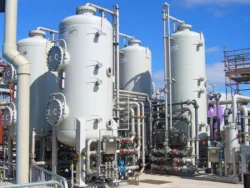AOP for PFAS
Advanced Oxidation Processes (AOP) for PFAS: A Comprehensive Guide
Introduction: The Challenge of PFAS
Per- and polyfluoroalkyl substances (PFAS), often referred to as "forever chemicals," present significant environmental challenges, particularly in water quality management. As of July 30, 2025, the U.S. Environmental Protection Agency (EPA) has declared PFAS a critical pollutant, prompting stringent regulations aimed at reducing their prevalence in drinking water supplies. With regulatory frameworks tightening and public awareness escalating, water treatment facilities and environmental engineers are urgently seeking effective solutions to remediate PFAS contamination. Advanced Oxidation Processes (AOP) represent a cutting-edge method for the degradation of these persistent pollutants. This article explores the technology behind AOP, its effectiveness for PFAS removal, and its implications for municipalities and industries dealing with water treatment.
Understanding AOP
What are Advanced Oxidation Processes?
Advanced Oxidation Processes utilize highly reactive hydroxyl radicals (•OH) to oxidize organic pollutants, including PFAS, into simpler, non-toxic compounds. AOP encompasses various techniques, including:
- Ozone (O₃) Oxidation
- Hydrogen Peroxide (H₂O₂) based Treatments
- Ultraviolet (UV) Light Coupled with Ozone or Hydrogen Peroxide
- Fenton’s Reagent (Iron Salts with Hydrogen Peroxide)
Core Mechanisms of AOP
The effectiveness of AOP lies in its ability to generate hydroxyl radicals from oxidants such as ozone or hydrogen peroxide. For instance, the decomposition of hydrogen peroxide in the presence of iron (in Fenton’s reaction) can create hydroxyl radicals:
[ \text{Fe}^{2+} + \text{H}_2\text{O}_2 \rightarrow \text{Fe}^{3+} + •\text{OH} + \text{OH}^- ]
Applied in the context of PFAS, these radicals can break the carbon-fluorine bonds characteristic of PFAS molecules, leading to their transformation into less harmful substances like carbon dioxide and fluoride.
Regulatory Framework and Recent Developments
EPA Guidelines and Actions
In response to growing concerns over PFAS, the EPA has enacted several regulations targeting these substances. As of 2025, the agency has recommended maximum contaminant levels (MCLs) for specific PFAS in drinking water, including PFOA and PFOS, at 0.004 parts per trillion (ppt). According to the EPA Electric & Water Treatment Regulation released in early 2025, municipalities must implement remediation technologies capable of achieving these limits.
Implications for Water Treatment Facilities
The evolving regulatory landscape necessitates the immediate adoption of efficient technologies like AOP. Water treatment facilities must balance compliance with regulatory mandates while managing operational costs, making AOP an appealing option due to its adaptability and effectiveness.
Problem-Solution Approach: AOP for PFAS Removal
Efficacy of AOP in Removing PFAS
Performance Analysis
Research shows that AOP can degrade various PFAS compounds effectively:
- Ozone Treatment: Studies in 2024 indicated that AOP systems utilizing ozone could achieve over 90% removal of PFAS from contaminated water within a short retention time.
- Hydrogen Peroxide and UV: The combination of UV light and hydrogen peroxide has demonstrated efficacy in breaking down long-chain PFAS molecules, with some systems recording over 95% degradation rates in pilot studies.
Case Studies and Field Applications
In 2025, a case study involving a New Jersey municipal water treatment plant illustrated the successful implementation of an AOP system. Initial tests showed PFAS concentrations at 200 ppt, but post-treatment results fell below the EPA’s MCL of 0.004 ppt. This success story underscores the potential of AOP as a viable solution for widespread PFAS contamination.
Pros and Cons of AOP for PFAS Treatment
Advantages
- Comprehensive Degradation: Unlike conventional methods, AOP can break down the entire PFAS family, addressing both short- and long-chain compounds.
- Real-Time Monitoring: Advanced AOP systems can incorporate real-time monitoring technologies to ensure continuous compliance with regulatory standards.
Disadvantages
- Capital and Operational Costs: The initial investment in AOP technologies can be substantial, leading to concerns among budget-constrained municipalities.
- By-products: The degradation process may generate by-products that require further treatment, necessitating a comprehensive understanding of the AOP system’s overall impact.
Implementation Strategies for AOP
Designing an AOP System for PFAS Treatment
System Components
- Pre-treatment Unit: Screening and pre-filtration to remove large particulates.
- AOP Reactors: Integrating ozone, hydrogen peroxide, or UV systems tailored to specific PFAS challenges.
- Post-treatment Solutions: Employing granular activated carbon (GAC) or advanced filtration to capture degradation products.
Best Practices in Operation and Management
- Continuous Monitoring: Employ sensors for real-time analysis of PFAS levels entering and exiting the AOP system.
- Regular Maintenance: Schedule routine inspections and maintenance on AOP equipment to ensure optimal performance and longevity.
The Future of AOP for PFAS
As we move deeper into 2025 and beyond, the need for effective PFAS remediation technologies will only increase. Innovations in AOP systems are underway, with researchers exploring hybrid approaches that combine AOP with other remediation technologies for even greater effectiveness.
The Role of Emerging Technologies
Advancements such as machine learning algorithms for predictive maintenance and improved degradation efficiency can significantly enhance AOP systems. Additionally, partnerships between regulatory agencies, research institutions, and technology developers will play a crucial role in refining AOP applications for PFAS.
Conclusion: A Viable Path Forward
In summary, Advanced Oxidation Processes offer a powerful tool for addressing the critical challenge of PFAS contamination in water. With the evolving regulatory landscape, water treatment facilities must act swiftly and effectively. As we continue to confront the implications of PFAS on public health and the environment, AOP stands out as not only a viable method for meeting regulatory requirements but also a promising solution for enhancing water quality in communities nationwide. The pursuit of innovation in AOP technology will be essential for achieving sustainable water treatment practices that safeguard public health and the environment for future generations. Overall, embracing AOP could be pivotal in the ongoing challenge against PFAS, representing a significant step forward for the water treatment industry.
By understanding the mechanisms, regulatory context, and operational strategies of AOP for PFAS, stakeholders can navigate the complexities of water treatment effectively while ensuring compliance and safeguarding public health.



